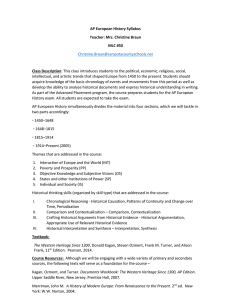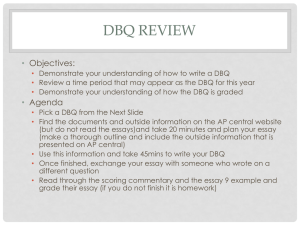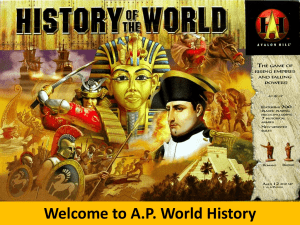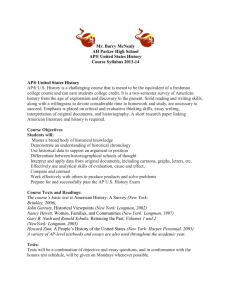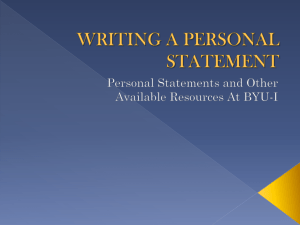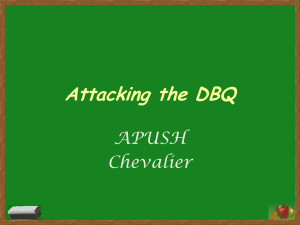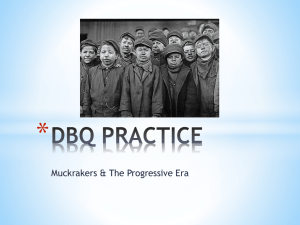APUSH DBQ Essays - Ottumwa Community Schools
advertisement
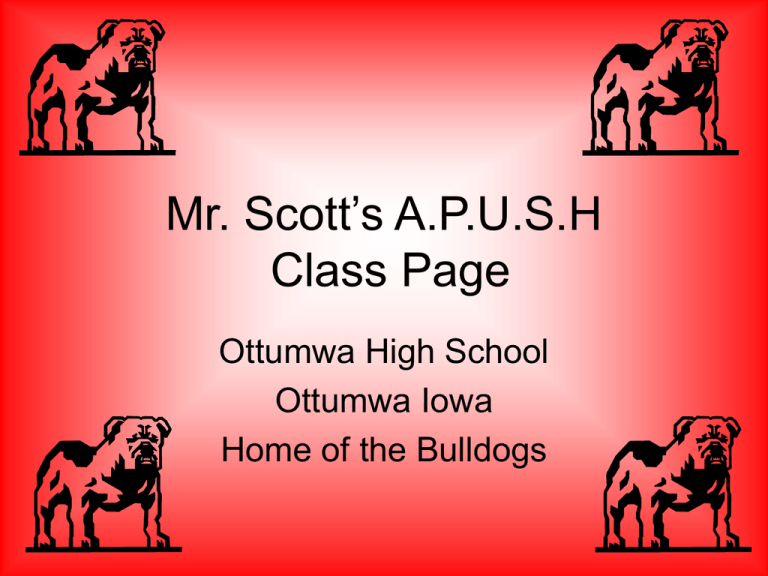
Mr. Scott’s A.P.U.S.H Class Page Ottumwa High School Ottumwa Iowa Home of the Bulldogs Student Generated DBQ Project • Students were to create a DBQ question from scratch. • Students had to formulate a position question, from any topic we covered through text content or class discussion/debate. • Next they needed to research and find 8-10 documents, in total that presented both sides of the issue. • These documents had to be of a nature, that would allow others to use them to formulate their own DBQ essay, for my class or any other that saw them on this site. • Finally the students had to write an Essay that answered the question they posed, using only the documents they researched and posted. • This is in lieu of a written content final, since they’ve already taken the AP Exam. Which is the whole point isn’t it? • Each student’s documents and essay are attached as individual links. Student Links Subject By Julie H. Subject By Elizabeth B. Subject By Aaron L. Subject By Tom S. Subject By Jennifer H. Subject By Frances D. Subject By Haliegh B. Subject By Danielle L. Mr. Scott’s APUSH Syllabus • AP United States History • Course Description • AP U.S. History is a two-semester survey of American History from the age of discovery to the present. This is a challenging course that is meant to be the equivalent of a freshman college course and can earn students college credit. The successful AP student must possess solid reading and writing skills, a willingness to devote considerable time to homework and studying. Due to the rigorous and challenging nature of the AP exam this class will focus on critical and evaluative thinking skills, essay writing, interpretation of original documents, and other fact-based data. • Course objectives- Students will: • Prepare for and successfully pass the Advanced Placement Exam • Master a broad and vast amount of historical knowledge • Demonstrate an understanding of historical chronology • Learn how to support or defend an argument or position using historical data • Interpret and apply data gathered from original documents such as graphs, cartoons, letters, and eyewitness reports. • Develop skills necessary to analytically evaluate, determine cause and effect, as well as compare and contrast. • Work effectively with others to solve problems and work in other cooperative settings • • Course Texts and Readings Required reading of the textbook: American Pageant13th edition, Houghton Mifflin • Supplemental texts: Lies My Teacher Told Me: Everything Your American History Book Got Wrong, 1st edition, Simon & Schuster • • A People’s History of the United States 1492-Present, Harper Collins Publishers • Taking sides: Clashing Views on Controversial Issues in • • American History volumes 1 and 2 10th editions, McGraw-Hill / Dushkin • There will be other excerpts from other texts, primary and secondary sources to read in the classroom as catalysts for group discussions and essay subjects. 1.Units of Study and Tentative Reading Schedule Begin First Semester Founding the New Nation Week 1. Chapter 1 2. Chapters 2&3 3. Chapters 4&5 4. Chapters 6,7, &8 Unit Topics: Cross cultural encounters with Native Americans * Patterns of Colonial settlement * Role of religion in colonial society * Causes of the Revolution* Pros and Cons of mercantilism* Role of government in relation to the needs of the people Activity Examples: Salem Witchcraft Trials Topics Reader-Document Analysis First DBQ writing assignment- French & Indian War (AP test 2004) Work on establishing a quality Thesis statement Multiple choice and essay exam covering unit topics Building the New Nation Week 5. Chapters 9&10 6. Chapter 11 7. Chapter 12 8. Chapter 13 9. Chapters 14&15 Unit Topics: Confederation vs. Constitution* The Precedence of a Constitution* The Constitutional Governments Affect on the People * Foreign Policy Beginnings * 1800 Revolution * Western Expansion and Indian Removal * New American Identity & Nationalism * Reformation, Temperance, & Utopia Activity Examples: Whole group discussion over President Washington’s Warning against foreign entanglements Political debate- Federalists and republican ideas DBQ (AP Test 2002) “Reform movements in the United States sought to expand Democratic ideals.” Assess the validity of this statement with specific references to the years 1825-1850. Multiple choice test and essay exam covering unit topics Testing the New Nation Week 10. Chapter 16 11. Chapter 17 12. Chapter 18 13. Chapter 19 14. Chapter 20 15. Chapter 21 16. Chapter 22 Unit Topics: Evolving Attitudes about Slavery * Expansion vs. Sectionalism * Attempts at Compromise * Election of 1860 & Secession * Mexican war & Texas * Popular Sovereignty * Diplomacy of the Civil War * Key Civil War battles* Impact & Consequences of the Civil War * Black Codes * Radical ness of Reconstruction * The Legacy of Reconstruction. Activity Examples: “Who freed the slaves?” Group activity analyzing both primary and secondary sources from different points of view. Read and interpret whether President Lincoln’s Inaugural Speech was a call for Peace or War. Students will create their own northern or southern newspaper that incorporates the major topics covered in the unit, elements include but not limited to opinion editorials, illustrations& political cartoons, Society and cultural essays, and War/political reporting. Multiple choice test and essay exam covering unit topics Week 17. Historical Novel analysis due Varies from student to student, depending upon their Chosen topic and Novel read. Week 18. First Semester Final Exam Modeled after the AP exam in timing and format. Specific dates determined by School Administration and to Coincide with the proposed final schedule for the entire student body. Begin Second Semester Forging an Industrial Society Week 1. Chapter 23 2. Chapter 24 & 25 3. Chapters 26&27 Unit Topics: Social, Economic, and Political Impact of Industrialization* Unionization and the Worker* Role and Effect of Political Third Parties* The Change in America’s role in World Affairs* American Expansionism Activity Examples: Students research and analyze examples of propaganda, then make their own propaganda cartoon, posters, or song. Students will research and compile documents that answer their own student created DBQ on any of the above unit topics Write an essay that illustrates or justifies your opinion on which area was most effected by industrialization (social, economic, political) V. Struggling for Justice at Home and Abroad 4. Chapters 28&29 5. Chapter 30 6. Chapters 31&32 7. Chapter 33 8. Chapter 34 9. Chapter 35 Unit Topics: Reactions to Social Injustice, Corruption and Muckraking* Progressive Era Presidents: Compare and Contrast* America’s Role and Motives in WWI* Post WWI Agreements* Isolationism, Nativism and the Fourteen Points* Red Scare, Shared Culture, & Mass Consumption* Governments Role in Society, Crime Fighting, and Economics during prohibition* Crash, Depression, and the New Deal* “Good Neighbors?” Latin America and Asian Policies Activity Examples: Students create a yellow journalism headline and front page story over someone or something covered in this unit Compare and contrast Hoover and Roosevelt’s’ plan for economic recovery during the great depression Examine the Treaty of Versailles and establish what aspects of it and subsequent events made it a cease-fire for twenty years instead of a truce. Making Modern America 10. Chapter 36 11. Chapter 37 12. Chapter 38 13. Chapter 39 14. Chapter 40 15. Chapter 41&42 Unit Topics: America’s Motives for Entering WWII* Allian Planning* Home Front Issues and Conduct During WWII* Origins an the Cold War* Struggle for Civil Rights, Liberties, and Equality* Vietn and Reactions* Domestic Policies and Social Reactions* Watergate Crisis’s of the Seventies* Roots of Conservatism* End of the Cold W Position on the World Stage at the end of the 20th Century Activity Examples: Students will play axis and allies then compare how their strategies f similar or different to those of commanders in WWII Write an essay that traces the development of the women’s moveme to the 1970’s DBQ (2001) what were the Cold War fears of the American people in the Second World War? How successfully did President Eisenhower fears? Create a chart that places key cold war events under the administrat within from Eisenhower to G.H.W. Bush.

